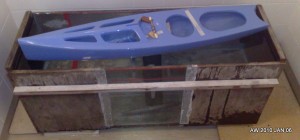The PIKANTO is designed with a hull-depth very close to the maximum 60 mm permitted by the rules. Just to make sure we put our first hull in a tank today and looked at the depth. The hull weighs 600 g, so with a 2500 g fin/bulb combination and a 55 g rudder we added roughly 900 g of ballast to get just above the minimum weight of 4000 g. The measured hull-depth is very close to the design depth of ~59 mm.
No problems with the hull depth! Production will likely continue on Saturday.

Congratulations!
hopefully going to be cheap!
Hi Toni,
We have about 5-6 boats to make for Finnish customers first, and our own two prototype boats. After that we will probably sell the boat internationally also.
Right now it looks like the hull moulding straight from the mold, including hull, deck, and fin/mastbox will cost 500euros.
To this we can add the jib-support, mainsheet-post, radio-moulding, fin, bulb, and rudder. A boat ready for electronics and rigs will probably cost 1000euros.
Anders
If the boat is designed to 60 mm hull-depth, and has build by Numeric Control... Wath is the reason to have a depth of only 59 mm?
Milled MDF plugs pieces are glued together and sanded by hand. There can easily come something like 0.5-1 mm errors to designed dimensions. CNC mill makes just a small part of this job, most of this work is still handwork. However, I think this is one of the most accurately build IOM's around.
There is also 8mm wide slot for keel, and that slot
cut's away deepest part from the hull.
Most accurate way to do moulds for these boats
would be to CNC machine moulds from aluminium or from mould steel. Price for those kind of moulds will be astronomical. But there will still be errors in mould dimensions. When large amounts of metal is removed from big solid metal piece, it
will bend and twist. I think it could be reasonable to expect somethign like 0.2-0.3 mm accuracy for IOM hull metal moulds.
Jari
Graham Bantock, the designer of the PIKANTO, has clarified this a bit for those of you who are wondering about the depth numbers.
"... I can tell you that the design hull depth for PIKANTO is 59.3 mm and, because the fin box cavity occurs at the deepest point, and the deepest part of the hull moulding is cut away 5 mm each side of the centreline, the deepest part of the actual hull is only 59.1 mm below the waterline. So we have a 0.9 mm margin for error in the construction of the boat. Alternatively, if the boat is built to exacting standard, some 120 grams additional weight could be added before there is a problem with the boat being over depth. "
Anders